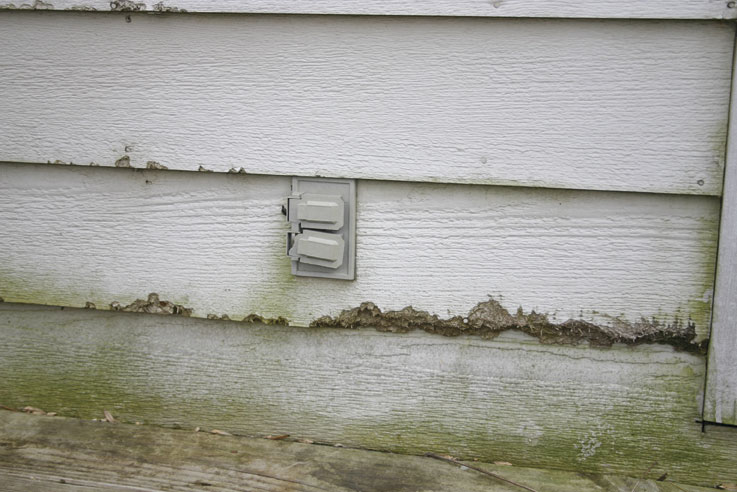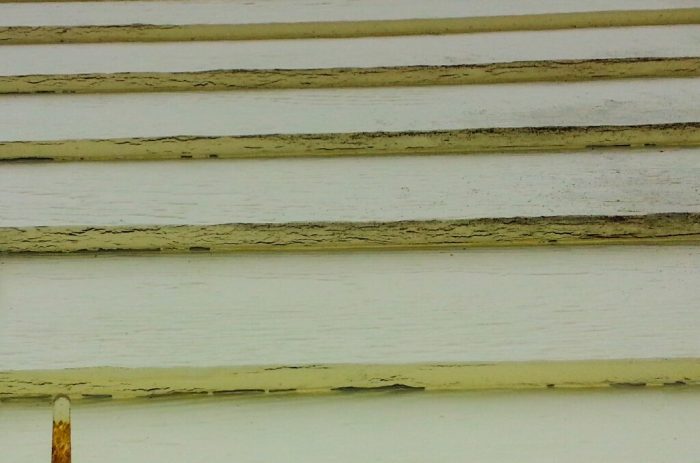The evolution of composite siding over the past 40 years is a story that will long be told in the building products industry. The concept of strand board composite real wood siding isn’t new, but the history is complicated and has repeatedly proven itself more of a problem, than a solution. As far as we’re concerned, once siding is installed your home, it should solve your problems, not become one.
The most common problem we see with residential siding materials out there, hands down, is Louisiana-Pacific Inner Seal Siding.
After Georgia-Pacific spun off several divisions in 1972, Louisiana-Pacific was born. Building through acquisitions, the company bought Fiberboard Corporation and fifteen southern California building centers that provided a distribution network. For long-term success however, the company needed to make-up for lost revenue with the sputtering of solid wood lumber production Southern Pine and Douglas Fir. In the late 1970’s, the company began manufacturing oriented strand board (OSB) by slicing logs into various sized wafers mixed with resin and pressed into panels or sheets. First introduced as Wafer-Wood and later renamed as Inner Seal, the product revolutionized the lumber industry by offering a less expensive and stronger alternative to plywood sheathing. LP advertised the product as “the smart man’s plywood.”
Success of the product led to the manufacturing of many engineered wood products including the simulated cedar Inner-Seal siding.

In response to repeated siding condition issues, especially product manufactured between early 1990 through 1996, LP was forced to defend a major class action suit (http://www.sidingsolutions.com/pages/classtat.htm) and paid claims for the product discoloring, disintegrating, and even growing fungi. Two years after the suit and after LP settled all related suits, the product was re-engineered and is now marketed as LP SmartSide – http://www.lpcorp.com/smartside/lap/resources/. Since 1997 the company has sold approximately three billion square feet with no warranty claims.
So that brings us to today. Though the class action helped some homeowners with repair costs, there is still a lot of Inner Seal siding is still on houses. The most common issue we still see is swelling at the edges with some panels clearly delaminating. It’s pretty clear that swelled, recalled, moisture-compromised LP siding should be replaced. With a thorough inspection, nearly all composite fiberboard, hardboard or OSB siding has failed.
It is important to understand that once the product fails and swells you cannot reverse the deterioration, by painting for instance. In fact, painting can seal moisture in and accelerate the process. So what should you do? Get prepared to replace. Do research on different siding materials including steel, vinyl, real cedar wood, and aluminum. Get estimates so the expense is anticipated and you’re not surprised at the cost of siding replacement. The process or siding replacement is quite involved and includes demo of the existing siding and usually destroying the tarpaper or vapor barrier. The trim may need to be removed and replaced depending on the configuration. Then a new barrier installed followed by new siding and trim.

Bottom line, if you’re buying a house take a close look at the edge of the siding at the bottom layers. If it’s the failing, you will usually see swelling and/or delaminating. Measure the thickness and compare the measurement to siding that is weather protected, for instance under an eave or in a porch. The siding should measure approximately one-half inch. There have been reported measurements at lower courses that exceed one inch.
As far as LP SmartSide (the newer product that “hasn’t had a claim since 1997”), we encourage you to read the disclaimers on the warranty information http://lpcorp.com/media/1419/lp-smartside-warranty-english.pdf. It looks like they went a long way to protect themselves from another class action.
ABOUT US
Wrightway Home Improvements is the best siding installer in Fond du Lac, Oshkosh, and Appleton areas. We have an expansive service area and we are experts in replacing siding, windows, and gutters and installing gutter guards. If you think your siding might need a fresh update, we can help you each step of the way and free up some of your time for more important things. Find out more about our seamless steel siding at www.WrightwayBuilt.com.




